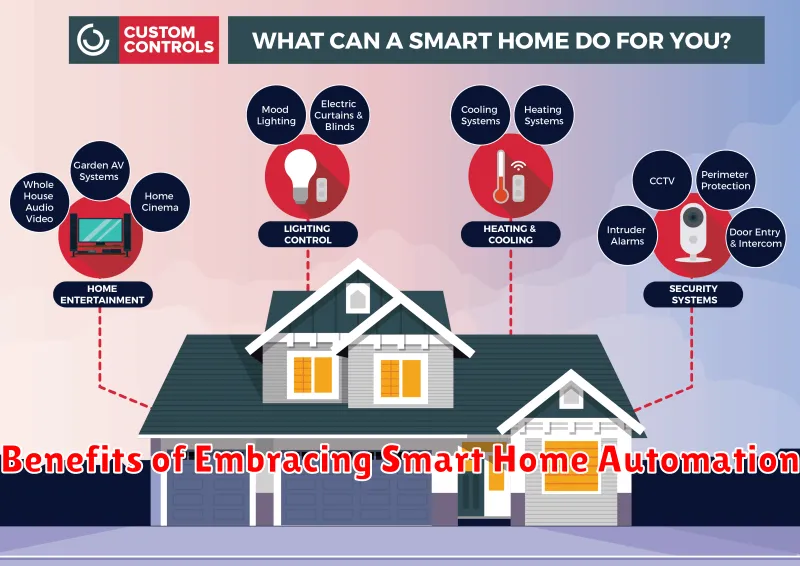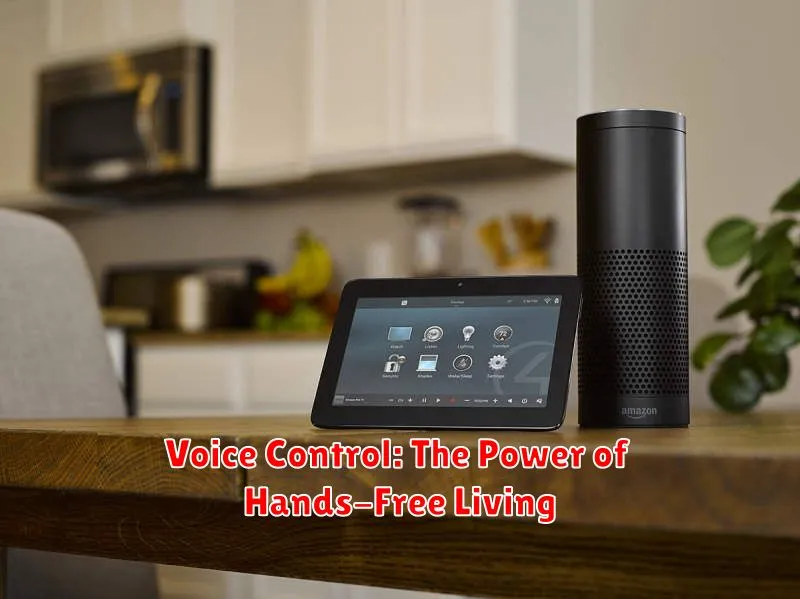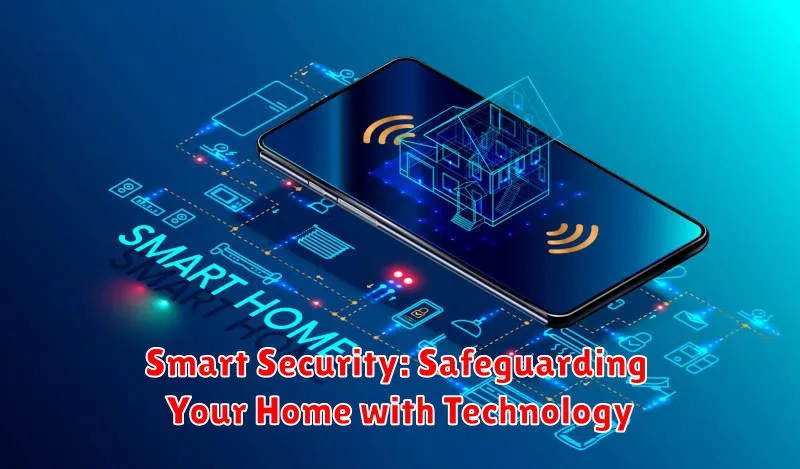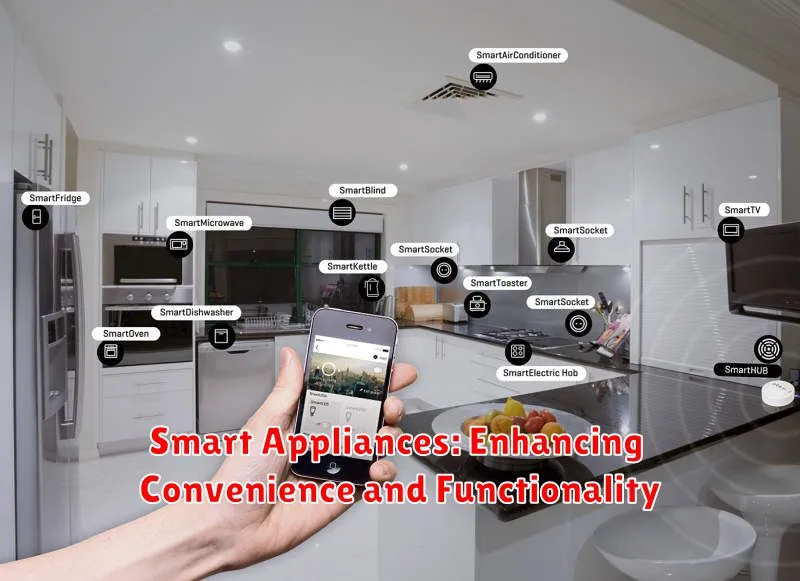Step into the future of living with smart home automation systems! Imagine a world where your home responds to your every need, anticipating your desires and making your life easier than ever before. From controlling your lights and temperature to managing your appliances and security, smart home automation is revolutionizing the way we live.
This in-depth guide will explore the exciting possibilities of smart home automation, delving into its benefits, key features, and the latest advancements. We’ll unravel the complexities of integrating different systems, addressing common concerns, and showcasing how these innovative technologies can enhance your comfort, safety, and energy efficiency.
Understanding Smart Home Automation
Smart home automation is the use of technology to control and automate various aspects of your home, such as lighting, temperature, security, and appliances. It involves integrating devices, sensors, and software to create a seamless and interconnected living environment. At its core, smart home automation aims to simplify your life, improve comfort, enhance safety, and provide greater control over your home’s functionality.
The foundation of smart home automation lies in the Internet of Things (IoT), where devices are connected and communicate with each other through the internet. This enables you to remotely manage and monitor your home’s systems from anywhere in the world. By using smartphone apps or voice assistants, you can interact with your devices and automate tasks, such as turning off lights, adjusting the thermostat, locking doors, or receiving alerts when motion is detected.
Smart home automation offers a wide range of benefits, including:
- Enhanced Convenience and Comfort: Automated tasks free up your time and effort, allowing you to focus on other things. You can set schedules for lights and appliances, adjust the temperature to your preference, and control your home’s environment with ease.
- Increased Security: Smart home systems can enhance security by providing features like remote monitoring, motion detection alerts, door and window sensors, and security cameras. These features deter intruders and offer peace of mind.
- Energy Efficiency: Smart home devices can help optimize energy consumption by automating tasks such as turning off lights when rooms are empty or adjusting the thermostat based on your schedule and presence.
- Accessibility and Control: Smart home technology can benefit individuals with disabilities by providing remote control of appliances and devices, making it easier to access and use everyday items.
- Personalized Experiences: Smart homes can learn your preferences and habits, providing tailored experiences based on your individual needs. For example, your lights may dim automatically at sunset, or your music may start playing when you enter a specific room.
As smart home technology continues to advance, we can expect even more innovative features and applications that will further enhance our living experiences. From voice-controlled appliances to AI-powered home assistants, the future of home automation promises to be exciting and transformative.
The Core Components of a Smart Home System
Stepping into the realm of smart home automation can feel overwhelming, but at its core, it’s built on a few essential components. Understanding these building blocks can illuminate the potential of this technology and guide you in making informed decisions.
1. Hub or Controller: The heart of your smart home, this central device acts as a command center, connecting all your smart devices and enabling communication between them. Popular options include the Amazon Echo, Google Home, and Samsung SmartThings.
2. Sensors and Actuators: These components gather data about your environment and trigger actions accordingly. Sensors can detect things like motion, temperature, light, and sound, while actuators put those readings into action. Examples include motion sensors triggering lights, temperature sensors controlling thermostats, and door sensors activating security systems.
3. Smart Devices: These are the tangible elements that enhance your home’s functionality, from smart lights and thermostats to security cameras and appliances. Each device offers unique features and capabilities, allowing you to personalize your smart home experience.
4. Connectivity: A stable and reliable internet connection is crucial for a seamless smart home experience. It enables communication between your hub, sensors, actuators, and smart devices, ensuring everything operates smoothly.
5. Software and Apps: These interfaces provide control and management over your smart home ecosystem. Through user-friendly apps, you can customize schedules, set routines, monitor activities, and access device settings.
These core components, when interconnected, create a powerful ecosystem that allows you to automate tasks, enhance convenience, and improve energy efficiency. As technology advances, new components and features will continue to emerge, further unlocking the potential of a truly intelligent home.
Benefits of Embracing Smart Home Automation

In today’s fast-paced world, convenience and comfort are highly sought after. Smart home automation systems offer a seamless blend of technology and lifestyle, transforming ordinary homes into intelligent havens. Embracing these systems unlocks a world of benefits that enhance our daily lives in numerous ways.
One of the most significant advantages of smart home automation is enhanced security. With features like smart locks, security cameras, and motion sensors, homeowners can monitor their property remotely and receive instant alerts in case of suspicious activity. This provides peace of mind knowing your home is protected even when you’re away.
Smart home automation also leads to increased energy efficiency. By automating lighting, temperature control, and appliances, you can optimize energy consumption and reduce utility bills. Smart thermostats, for example, can learn your preferences and adjust the temperature accordingly, ensuring your home is comfortable without wasting energy.
Another notable benefit is improved accessibility. Smart home automation allows individuals with disabilities or limited mobility to control various aspects of their home with ease. Voice assistants and remote controls can operate lights, appliances, and even security systems, making daily tasks more manageable and independent.
Beyond practicality, smart home automation offers a personalized living experience. Customized lighting scenes, music playlists, and even automated curtains create an ambiance that aligns with your mood and preferences. The ability to control your home environment with just a voice command or a tap on your smartphone adds a touch of luxury and convenience to everyday life.
Finally, smart home automation systems can increase home value. Prospective buyers often view smart home features as a desirable and valuable addition, potentially commanding a higher price in the real estate market. This investment in home automation can be a wise financial decision in the long run.
Popular Smart Home Ecosystems: A Comparative Analysis
The world of smart homes is rapidly expanding, offering a wealth of possibilities to enhance comfort, security, and energy efficiency. At the heart of this revolution lie smart home ecosystems, platforms that connect and control various smart devices. With so many options available, choosing the right ecosystem can be daunting. This article provides a comparative analysis of some of the most popular smart home ecosystems, helping you make an informed decision based on your specific needs and preferences.
Amazon Alexa
Amazon Alexa, powered by the Alexa voice assistant, is a leading smart home ecosystem known for its extensive device compatibility, user-friendly interface, and robust voice control capabilities. It integrates seamlessly with a wide range of smart devices, including lights, thermostats, security cameras, and appliances. Alexa’s “Alexa Skills” platform offers a vast library of voice-activated functions, expanding its functionalities beyond home automation.
Google Home
Google Home, powered by the Google Assistant, is another popular contender in the smart home arena. It boasts a strong focus on artificial intelligence (AI), offering a personalized experience through machine learning algorithms. Google Home excels in its seamless integration with Google services, such as Google Maps, YouTube Music, and Calendar. It also supports a wide range of smart devices, providing comprehensive home control.
Apple HomeKit
Apple HomeKit is a closed ecosystem designed for Apple users. It prioritizes privacy and security, offering a robust platform for controlling HomeKit-compatible devices. HomeKit is renowned for its intuitive user interface, seamless integration with Apple devices like iPhones and iPads, and strong emphasis on data privacy.
Samsung SmartThings
Samsung SmartThings offers a comprehensive smart home ecosystem that focuses on both hardware and software solutions. It provides a wide range of smart home devices, including hubs, sensors, and appliances. SmartThings excels in its “SmartThings Hub”, which acts as a central control point for all connected devices, ensuring a smooth and reliable experience.
Hubitat Elevation
Hubitat Elevation is a local processing hub that emphasizes privacy and security. It does not rely on cloud servers for operation, ensuring faster response times and greater control over data. Hubitat is known for its “Hubitat Elevation Hub”, which is capable of controlling a wide range of smart devices, including those that are not compatible with other ecosystems.
Choosing the Right Ecosystem
The best smart home ecosystem for you depends on your individual needs and preferences. Consider factors such as:
- Device Compatibility: Ensure that the ecosystem supports the devices you currently own or plan to purchase.
- Voice Assistant: Choose an ecosystem with a voice assistant that you find intuitive and comfortable to use.
- Privacy and Security: Assess the ecosystem’s privacy and security features, including data encryption and access control.
- Integration with Other Services: Determine if the ecosystem integrates seamlessly with other services you use, such as streaming platforms or calendar apps.
By carefully considering these factors, you can choose a smart home ecosystem that empowers you to unlock the future of living with comfort, convenience, and peace of mind.
Integrating Devices: Ensuring Seamless Connectivity
The allure of a smart home lies in its ability to seamlessly connect various devices, creating a truly integrated living experience. Interoperability is the cornerstone of this connectivity, ensuring that different brands and technologies can communicate and work together harmoniously.
Achieving seamless integration involves carefully considering several crucial factors:
- Standards and protocols: Smart home systems often rely on different communication protocols such as Zigbee, Z-Wave, Bluetooth, Wi-Fi, and Ethernet. Choosing devices that support compatible standards is crucial for ensuring smooth interactions.
- Hubs and gateways: These devices act as central control points, translating data between different protocols and facilitating communication between devices. Selecting a robust hub that supports a wide range of protocols is essential for a truly integrated system.
- Device compatibility: Before integrating devices, it’s important to check for compatibility with the chosen hub or system. Many manufacturers offer compatibility lists or online tools to assist with this process.
- Cloud-based services: Cloud services play a crucial role in connecting devices and enabling remote control. Ensure that the chosen system offers a reliable and secure cloud platform.
By carefully selecting devices and ensuring compatibility, smart home users can unlock a world of interconnected possibilities. From controlling lighting and temperature to managing security and entertainment, a well-integrated smart home offers unparalleled convenience and control.
Voice Control: The Power of Hands-Free Living

In the realm of smart home automation, voice control stands as a transformative force, empowering us with the ability to interact with our living spaces effortlessly. With a simple spoken command, we can now control a myriad of devices, from lighting and temperature to entertainment systems and security measures. This hands-free technology has revolutionized our homes, offering convenience, efficiency, and a touch of futuristic flair.
The allure of voice control lies in its inherent simplicity. Imagine a world where you can dim the lights, adjust the thermostat, or play your favorite music with just your voice. This eliminates the need for fumbling with switches, remotes, or touchscreen interfaces. With voice control, home automation becomes an intuitive and seamless experience, accessible to all, regardless of age or tech proficiency.
Beyond its convenience, voice control also unlocks a realm of possibilities for accessibility. For individuals with limited mobility or dexterity, voice control provides a liberating alternative to traditional methods of device operation. It empowers them to enjoy the full range of smart home functionalities with ease and independence. Moreover, voice control can cater to diverse needs, allowing users to customize their home environment to their specific preferences.
As voice control technology continues to evolve, we can expect even more sophisticated and personalized experiences. Integration with other smart home systems and platforms will create a truly connected and responsive living space, where your voice becomes the key to a seamless and intuitive home automation experience. From the comfort of your couch or the convenience of your kitchen, voice control empowers you to orchestrate your home environment with effortless grace.
Smart Lighting: Illuminating Your Life with Intelligence

In the realm of smart home automation, smart lighting stands out as a transformative technology, seamlessly blending convenience, energy efficiency, and security. It empowers you to control your home’s illumination with unprecedented precision, transforming the way you interact with your living spaces.
One of the most compelling aspects of smart lighting is its customization. Imagine setting the mood with warm, soft lighting for a cozy evening or illuminating your kitchen with bright, cool white light for optimal visibility while cooking. With smart lighting, you can effortlessly adjust the brightness, color temperature, and even the color of your lights to suit your specific needs and preferences.
Beyond aesthetics, smart lighting offers significant energy savings. By automatically turning off lights when rooms are unoccupied and scheduling them to switch on and off based on your routines, you can reduce your energy consumption and electricity bills. Some smart bulbs even feature motion sensors, ensuring lights only illuminate when necessary.
Smart lighting systems also enhance your home security. With the ability to control your lights remotely, you can create the illusion that you are home even when you are away. This deterrent effect can discourage potential intruders. Moreover, smart lighting can be integrated with other smart home devices, allowing you to receive alerts if a motion sensor detects movement in your absence.
The future of home lighting is undoubtedly bright. As the technology continues to evolve, we can expect even more innovative features and functionalities. Imagine lighting that adapts to your circadian rhythms, providing optimal light levels throughout the day, or systems that respond to voice commands, seamlessly integrating into your daily life.
In conclusion, smart lighting offers a compelling blend of convenience, energy efficiency, and security, enriching your living experience in countless ways. As you embark on your journey into the world of smart home automation, smart lighting is an essential element to illuminate your life with intelligence.
Smart Security: Safeguarding Your Home with Technology

In the realm of home automation, smart security systems are emerging as a cornerstone of modern living, empowering homeowners with cutting-edge technology to safeguard their property and loved ones. These systems, seamlessly integrated with everyday devices, offer a comprehensive approach to security, transcending traditional methods and ushering in an era of proactive protection.
At the heart of smart security lies a network of interconnected sensors, cameras, and control panels that work in concert to monitor your home’s perimeter and interior. Motion sensors detect any unusual movement, alerting you instantly via smartphone notifications or sending a signal to your security company. Door and window sensors activate an alarm if unauthorized access is attempted, while smart cameras provide real-time video feeds, allowing you to keep an eye on your property remotely.
The beauty of smart security lies in its adaptability. You can customize your system to suit your specific needs and preferences. For instance, you can program different security settings for different times of the day, enabling a more relaxed approach during the day and heightened vigilance at night. The ability to control and monitor your system from anywhere in the world via a smartphone app adds a layer of convenience and peace of mind.
Beyond basic security, smart home security systems offer a range of advanced features, including: Automated lighting control to deter intruders by simulating occupancy, smart locks that allow you to grant access to authorized individuals remotely, and integrated smoke detectors and carbon monoxide detectors that can send alerts directly to your phone in case of an emergency.
The benefits of incorporating smart security into your home extend beyond just protection. These systems can help you save money on insurance premiums by demonstrating a reduced risk of theft. They can also improve your home’s energy efficiency by automatically controlling lighting and appliances. Ultimately, smart security offers a holistic approach to safeguarding your home and enhancing your overall quality of life.
Energy Efficiency: Reducing Consumption and Costs
Smart home automation systems are increasingly becoming a key aspect of modern living, offering convenience, comfort, and even environmental benefits. One of the most significant advantages of these systems is their ability to enhance energy efficiency, leading to reduced consumption and lower energy bills.
Smart thermostats are a prime example of how automation can save energy. These devices learn your preferences and automatically adjust the temperature of your home, ensuring optimal comfort while minimizing energy waste. They can also be programmed to automatically switch to eco-modes when you’re away, further reducing energy consumption.
Smart lighting is another area where automation shines. By using sensors, smart bulbs can automatically turn on and off based on your presence or the time of day, eliminating the need for manual control and preventing wasted energy. You can also control these lights remotely, ensuring that no lights are left on unnecessarily.
Smart appliances, like refrigerators and washing machines, are also contributing to energy efficiency. These appliances are designed to operate more efficiently and can be programmed to run at off-peak hours, when energy costs are typically lower. Some even feature intelligent features that help you optimize energy consumption based on your usage patterns.
Beyond individual devices, smart home automation systems can also optimize energy usage across your entire home. By integrating with other systems, such as solar panels or battery storage, these systems can ensure that energy is used efficiently and effectively. For example, they can prioritize using solar energy whenever available and automatically switch to stored energy during peak demand periods.
By embracing smart home automation, you can not only enjoy the comfort and convenience it offers but also contribute to a more sustainable future. With reduced energy consumption and lower bills, you can unlock the future of living, one intelligent system at a time.
Smart Appliances: Enhancing Convenience and Functionality

Smart appliances are revolutionizing the way we live, bringing a new era of convenience and functionality to our homes. These connected devices, often controlled through smartphone apps or voice assistants, offer a range of benefits that enhance our daily routines and create a more efficient and enjoyable living experience.
One of the most significant advantages of smart appliances is their ability to automate tasks, freeing up valuable time and reducing manual effort. For example, smart refrigerators can alert you when you’re running low on groceries, while smart washing machines can automatically adjust settings based on the type of laundry load. This level of automation simplifies daily chores, allowing you to focus on other activities.
Furthermore, smart appliances offer enhanced efficiency. They often come equipped with features like energy-saving modes, optimizing energy consumption and reducing utility bills. Smart thermostats, for instance, can learn your heating and cooling preferences and adjust temperatures accordingly, ensuring comfort while minimizing energy waste.
Beyond automation and efficiency, smart appliances also provide enhanced functionality. Smart ovens, for instance, allow you to remotely preheat your oven and monitor cooking progress from your smartphone. Smart coffee makers can brew your coffee at a specific time, ensuring a fresh cup ready when you wake up. These features add a level of convenience and control that was previously unimaginable.
Smart appliances are rapidly becoming an integral part of the modern home, transforming our lifestyles and creating a more comfortable and connected living experience. As technology continues to advance, we can expect even more innovative and intelligent appliances to emerge, further enhancing our convenience and functionality within our homes.
The Future of Smart Homes: Trends and Predictions
The smart home revolution is well underway, transforming the way we live and interact with our surroundings. As technology continues to evolve at an unprecedented pace, the future of smart homes holds exciting possibilities. Here are some key trends and predictions that will shape the landscape of connected living in the years to come:
Increased Personalization and Customization: Smart homes are becoming more tailored to individual needs and preferences. With advancements in artificial intelligence (AI) and machine learning, devices can learn user habits, predict needs, and automatically adjust settings for optimal comfort and convenience. Imagine a home that anticipates your arrival, adjusts the temperature, and dims the lights accordingly, all without you lifting a finger.
Enhanced Security and Safety: Smart home technology is playing a crucial role in enhancing security and safety. From intelligent surveillance systems with facial recognition capabilities to smart locks that integrate with your smartphone, residents can rest assured that their homes are protected from intruders. Furthermore, advancements in fall detection and emergency response systems are providing peace of mind for seniors and individuals with disabilities.
Seamless Integration and Interoperability: The future of smart homes lies in seamless integration between devices and systems. Imagine a home where your smart thermostat, lighting, and appliances communicate with each other to optimize energy efficiency and create a harmonious environment. This interoperability will be driven by open standards and platforms that foster a more unified smart home ecosystem.
Energy Efficiency and Sustainability: Smart homes are becoming increasingly energy efficient and environmentally friendly. With advancements in smart grids, energy management systems, and renewable energy integration, homeowners can reduce their carbon footprint and save money on utility bills. The future of smart homes will see a greater focus on sustainability, empowering residents to make responsible choices and contribute to a greener planet.
Voice Control and Natural Language Processing: Voice control is becoming the dominant interface for smart homes. With advancements in natural language processing, devices will understand and respond to complex commands and questions. Imagine controlling your home’s temperature, playing music, and checking the weather simply by speaking to a voice assistant.
The future of smart homes is bright and full of potential. As technology continues to evolve, we can expect to see even more innovative and intuitive solutions that enhance our quality of life, provide greater convenience, and empower us to live more sustainably.

